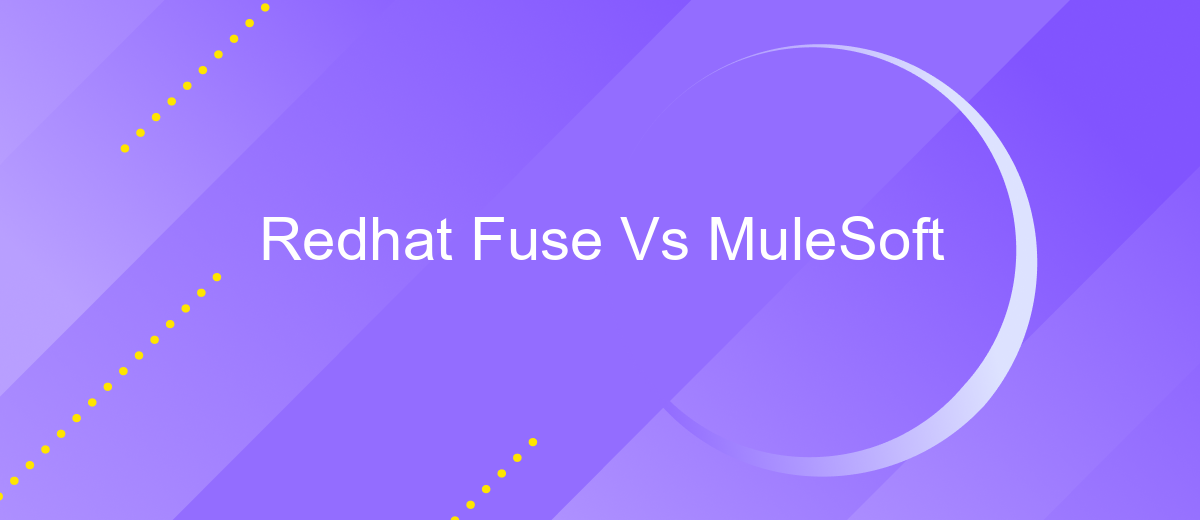Redhat Fuse Vs MuleSoft
When it comes to integrating complex enterprise systems, two prominent solutions often come into consideration: Red Hat Fuse and MuleSoft. Both platforms offer robust tools for connecting disparate applications and data sources, but they differ in architecture, ease of use, and scalability. This article aims to compare Red Hat Fuse and MuleSoft, helping you determine which solution best meets your business needs.
Introduction
In today's digital landscape, businesses are increasingly relying on integration platforms to streamline their operations and enhance connectivity between disparate systems. Two prominent players in this field are Redhat Fuse and MuleSoft, each offering unique features and capabilities to address diverse integration needs.
- Redhat Fuse: Known for its open-source foundation and robust support for enterprise-grade integrations.
- MuleSoft: Renowned for its comprehensive API management and extensive range of pre-built connectors.
Choosing the right integration platform can significantly impact business efficiency and agility. While Redhat Fuse excels in flexibility and customization, MuleSoft provides a seamless experience with its API-led connectivity approach. Additionally, services like ApiX-Drive can further simplify the integration process by offering user-friendly tools to automate data flow between applications, making it easier for businesses to achieve their integration goals.
Comparison of Features

Redhat Fuse and MuleSoft are both powerful integration platforms, but they offer distinct features that cater to different needs. Redhat Fuse is highly regarded for its open-source nature and flexibility, making it ideal for organizations that require extensive customization and control over their integration processes. It supports a wide range of connectors and protocols, allowing seamless integration across various systems. Additionally, Redhat Fuse's container-based architecture enables efficient deployment and scaling, ensuring robust performance in dynamic environments.
On the other hand, MuleSoft stands out with its comprehensive API management capabilities and user-friendly interface, which simplifies the integration process for businesses of all sizes. MuleSoft's Anypoint Platform provides a unified solution for API design, development, and management, streamlining the entire lifecycle. Furthermore, services like ApiX-Drive can complement MuleSoft by automating integrations between different applications, enhancing operational efficiency. While Redhat Fuse offers greater flexibility, MuleSoft excels in ease of use and end-to-end API management, making it a preferred choice for organizations prioritizing simplicity and comprehensive integration solutions.
Pricing and Licensing

When comparing Redhat Fuse and MuleSoft, pricing and licensing are crucial factors to consider. Both platforms offer flexible pricing models, but they cater to different business needs and budgets.
- Redhat Fuse offers a subscription-based model, which includes access to support and updates. Pricing varies based on the number of cores and environments.
- MuleSoft, on the other hand, employs a subscription model that scales with the number of applications, data volume, and environments. It also includes support and additional features like API management.
For businesses seeking to streamline their integration processes without heavy upfront costs, services like ApiX-Drive can be a viable alternative. ApiX-Drive offers a flexible pricing model based on the number of integrations and tasks, making it a cost-effective solution for smaller projects or specific integration needs.
Use Cases

Redhat Fuse and MuleSoft are two prominent integration platforms that cater to different business needs. Redhat Fuse is known for its open-source nature and flexibility, making it suitable for organizations that require extensive customization. MuleSoft, on the other hand, offers a comprehensive suite of tools for API management and integration, making it ideal for enterprises looking for an out-of-the-box solution.
Both platforms excel in various use cases, but their strengths cater to different scenarios. Redhat Fuse is often chosen for its ability to integrate with a wide range of systems using Apache Camel, while MuleSoft is preferred for its robust API management capabilities and ease of use.
- Redhat Fuse: Ideal for custom integrations in complex environments.
- MuleSoft: Best for API management and rapid integration deployment.
- ApiX-Drive: Simplifies integration processes with user-friendly tools.
When deciding between Redhat Fuse and MuleSoft, it's crucial to consider the specific requirements of your project. For instance, if you need a highly customizable solution, Redhat Fuse might be the better choice. However, if you prioritize ease of use and comprehensive API management, MuleSoft could be more suitable. Additionally, services like ApiX-Drive can further streamline your integration efforts, making the process more efficient and less time-consuming.
Conclusion
Both Redhat Fuse and MuleSoft offer robust solutions for enterprise integration, each with its unique strengths. Redhat Fuse excels in flexibility and open-source capabilities, making it an excellent choice for organizations looking for customizable and cost-effective solutions. On the other hand, MuleSoft stands out with its comprehensive Anypoint Platform, providing extensive pre-built connectors and a user-friendly interface, which can significantly speed up the integration process.
When deciding between Redhat Fuse and MuleSoft, it's crucial to consider your organization's specific needs and resources. For businesses looking to streamline their integration processes with minimal effort, leveraging services like ApiX-Drive can be highly beneficial. ApiX-Drive offers seamless integration capabilities, allowing for quick and efficient connection of various applications and services without the need for extensive coding knowledge. Ultimately, the choice between Redhat Fuse and MuleSoft should align with your integration strategy, budget, and long-term goals.


FAQ
What are the primary differences between Redhat Fuse and MuleSoft?
Which platform is more cost-effective for small to medium-sized businesses?
How do both platforms handle API management?
Can both platforms integrate with cloud services?
What are the best practices for implementing these platforms?
Time is the most valuable resource in today's business realities. By eliminating the routine from work processes, you will get more opportunities to implement the most daring plans and ideas. Choose – you can continue to waste time, money and nerves on inefficient solutions, or you can use ApiX-Drive, automating work processes and achieving results with minimal investment of money, effort and human resources.

